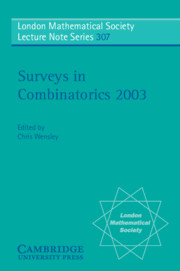Book contents
- Frontmatter
- Contents
- Preface
- W.T. Tutte, 1917–2002
- 1 Decompositions of complete graphs: embedding partial edge-colourings and the method of amalgamations
- 2 Combinatorial schemes for protecting digital content
- 3 Matroids and Coxeter groups
- 4 Defining sets in combinatorics: a survey
- 5 Finite projective planes with a large abelian group
- 6 Algorithmic aspects of graph homomorphisms
- 7 Counting lattice triangulations
- 8 Partition regular equations
- 9 Kostka–Foulkes polynomials and Macdonald spherical functions
5 - Finite projective planes with a large abelian group
Published online by Cambridge University Press: 05 May 2013
- Frontmatter
- Contents
- Preface
- W.T. Tutte, 1917–2002
- 1 Decompositions of complete graphs: embedding partial edge-colourings and the method of amalgamations
- 2 Combinatorial schemes for protecting digital content
- 3 Matroids and Coxeter groups
- 4 Defining sets in combinatorics: a survey
- 5 Finite projective planes with a large abelian group
- 6 Algorithmic aspects of graph homomorphisms
- 7 Counting lattice triangulations
- 8 Partition regular equations
- 9 Kostka–Foulkes polynomials and Macdonald spherical functions
Summary
Abstract
Let Π be a finite projective plane of order n, and let G be a large abelian (or, more generally, quasiregular) collineation group of Π; to be specific, we assume ∣G∣ (n2 + n + 1)/2. Such planes have been classified into eight cases by Dembowski and Piper in 1967. We survey the present state of knowledge about the existence and structure of such planes. We also discuss some geometric applications, in particular to the construction of arcs and ovals. Technically, a recurrent theme will be the amazing strength of the approach using various types of difference sets and the machinery of integral group rings.
Introduction
A projective plane is a geometry consisting of points and lines such that any two distinct lines meet in exactly one point, any two distinct points are on exactly one common line, and there are four points no three of which are collinear. Well-known examples are provided by the desarguesian (or classical) projective planes PG(2, q), q a prime power, which can be defined over the finite field GF(q) as follows: points and lines are the 1- and 2-dimensional subspaces of the vector space GF(q)3, and a point is incident with a line if and only if it is a subset of the line. A standard reference for arbitrary projective planes is Hughes and Piper [104]; for the desarguesian case, see Hirschfeld [89].
- Type
- Chapter
- Information
- Surveys in Combinatorics 2003 , pp. 175 - 238Publisher: Cambridge University PressPrint publication year: 2003
- 10
- Cited by



